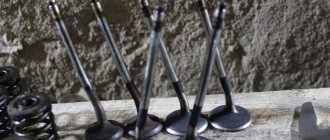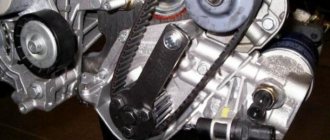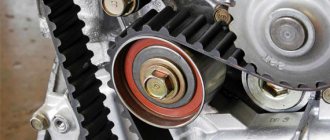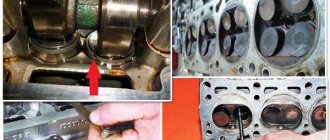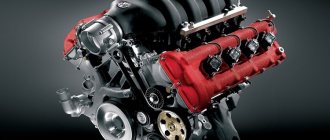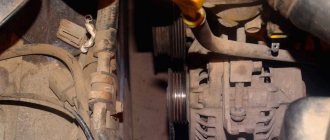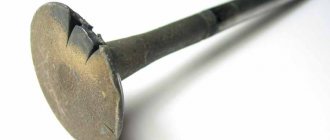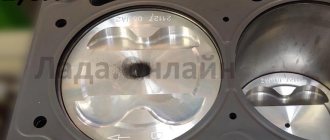Updated: 01/11/2022
Domestic cars remain the most popular in Russia. Buyers are practically forced to vote with their wallets for Ladas due to the lack of any reasonable alternatives. This is not to say that AvtoVAZ’s creations are available to buyers in the Russian Federation cheaply. Some configurations of domestic cars go far beyond a million rubles. And although it sounds paradoxical, someone still buys them. But today we will talk not so much about the marketing part, but about the technical part. If you are buying a Lada for a million, you would like to be sure that it will not break down due to some annoying error in the service.
In our article today we will look at which VAZ engines do not bend valves when the timing belt or chain breaks or jumps. And you will be surprised, but there are such engines in the line of domestic manufacturers. Unfortunately, until 2022, most engines still bent valves due to timing belt problems, but in new Lada engines this problem has actually been corrected.
So today we will look at several extremely important questions:
- VAZ engines on which the valves do not bend when the timing belt or chain breaks;
- Methods of protection against bending of valves in domestic engines;
- Specific examples of belt breaks on modern engines;
- How much does it cost to repair a VAZ engine after a broken timing belt.
Go!
Pistons of 8-valve engines
We are talking about engines 2111 and 21114. They are injection engines, and the shape of the pistons was inherited from the carburetor engine 2110.
ShPG elements (pistons) 2110-1004015
Actually, the same pistons were installed on three different 8-valve valves: 2110, 2111 (1.5 8v), 21114 (1.6 8v). Piston article number – 2110-1004015.
Two deep recesses ensure that any of the valves, intake or exhaust, cannot “meet” the piston surface even if the timing belt breaks.
The standard 8-valve valves on the VAZ-2112 do not bend the valves, no matter what some owners say. Sometimes an “improved” camshaft is installed, and if the valves fly out more than VAZ specifies, then there will be no guarantee against bending. Therefore, follow the regulations for replacing the timing belt on an 8-valve engine.
And the following is provided:
We give values taking into account the thermal gap. Whoever exceeds them will receive the result.
VAZ 2110 - “Tenth” family and new problems
“Tens” appeared in the VAZ model line quite a long time ago, but they gained popularity in 1998. Ten years later they were discontinued, giving way to new domestically developed products. Today, the “Ten” is considered a completely adequate vehicle with certain assembly problems. These models had different engines and had different characteristics:
- The 1.5-liter 8-valve simple power unit did not bend the valves, but showed only 72 horsepower;
- a modified 1.5-liter engine with 16 valves began to actively bend these same valves;
- a more modern 1.6-liter power unit in an 8-valve design should have been gentler, but it didn’t;
- You also won’t get cheap repairs after a broken timing belt on the most powerful 1.6-liter 16-valve VAZ 2110 engine.
The entire family of “Tenth” models was of quite high quality and reliable, but the further the plant tried to keep up with power, modernity and relevance, the more trouble the car got into. The most durable and high-quality engine was the 1.5 engine with 8 valves and 72 horses, but the latest models with powerful 16-valve units only encountered problems, judging by the reviews of car owners.
Do 16 valve engines bend?
Motors 21120 and 21124 are similar in design, but their displacement is different. The pistons are also installed differently - there are differences in the depth of the grooves.
ShPG elements (pistons) 2112-1004015 and 21124-100401504
In pistons 2112-1004015, the grooves are actually made. The likelihood of bending is reduced, but it is not reduced to zero. Therefore, always pay attention to the quality of the pump and rollers when replacing the timing belt on a 16-valve engine.
The VAZ-21124 engine is one of those 16-valve engines that do not bend their valves. The grooves are made so that no valve meets the piston.
Don't make the wrong choice.
Motors 21124 are in short supply!
One of the most favorite engines in the 12 is the 124. It doesn’t bend valves, drives great, and what else do you need?
The number of VAZ-21124 engines produced over the entire period is difficult to calculate. Maybe it even exceeds the number of 20 engines. Engine 21124 had a Euro-4 version, and this engine, regardless of the version, is in short supply. Prices also remain high. Well, the less voluminous 16-valve engine is rated lower, despite the fact that it is more powerful!
Nobody needs used engines that bend their valves now. A low-quality pump may jam, the belt will break and the owner will end up in capital trouble. Draw conclusions.
resource, parameters, photos and videos
AvtoVAZ is developing its 16-valve engines gradually, that is, step by step. When the updated Kalina family appeared in 2013, buyers were perplexed as to why they offered a 106-horsepower engine in manual versions, which differed little in design from the usual Priora engine.
The new engine was equipped with resonant supercharging, and it seemed that its presence would only have disadvantages: reliability was reduced, there was no way to connect the cable drive. But it turned out that the new engine was no worse than its predecessor: the mass air flow sensor often breaks down, and the DBP and DTV sensors almost never. There is no MAF sensor in the design of the 27th engine, which is the secret of increased reliability.
By the way, Lada Vesta with a Nissan engine is getting ready for release!
Why was the 27th engine replaced with the 29th?
The VAZ-21127 engine was good for everyone, except for one thing - it complied with Euro-4 standards. For Vesta sedans produced from November 2022, this option would not be suitable. It was necessary to solve a difficult problem: to improve the environmental class without increasing the volume and without losing power. And as a result, a new family of 16-valve engines appeared in the VAZ arsenal. We are talking about motors 21129 - they really meet the latest environmental standards.
The first Vesta engine, produced by VAZ
To move to the Euro-5 standard, engine 21127 had to be modified:
- The resonant intake system, as well as the exhaust system, have been completely redesigned;
- The ECU controller (ECM) has received new firmware - even the algorithm that regulates the volume of the resonant chambers has been changed;
- Engines 21127 and 21129 have slightly different compression ratios - 11.0 versus 10.45;
- The engine suspension was also improved: it became possible to mount it on a subframe.
It is clear what kind of engine the Lada Vesta would have had in 2022 and later if not for the transition to Euro-5. It would be the VAZ-21127 internal combustion engine, but with a modified suspension. And now we see that almost everything has been improved. As they say, changes are obvious.
What happened to the resource?
The resource value for the VAZ-21127 engine is 200 thousand km. In reality it is more. The engine must run all these “thousands” without replacing parts: only the belt tension is checked, the oil is changed, and there is no need to replace the timing belt.
Find out more about whether valves bend in a Lada Vesta engine here.
There is no need to “adjust the valves,” since the 16-valve engine is equipped with hydraulic compensators. Everything that is said here also applies to the latest VAZ development - the 21129 engine.
Note that the 27th and 29th engines do not differ much, while the second of them is operated in a more gentle mode. And this means that its resource will be at least no less than that typical for the ICE “21127” - 200 thousand and above!
On which VAZ engines does the valve bend, and on which ones does not?
Welcome, friends, to the DIY auto repair website. Experienced car enthusiasts know that a broken timing belt can lead to dire consequences. In particular, there is a high risk of “meeting” valves that have already come out of their seats and pistons rising by inertia.
Which VAZ engines bend valves
The result is deformation of vital engine elements, as well as an urgent need to visit a service station and carry out major repairs. But does the valve always bend when the timing belt breaks? Should we be afraid of this?
Foreign cars
Let's touch on the topic of foreign cars a little. Below is shown which engines from Toyota, Suzuki, Daewoo, Chevrolet, Citroen, Hyundai, Renault, Volvo, Kia, Fiat, Mercedes, Peugeot, Honda, Ford, Geely, Mitsubishi, Nissan, Audi, Volkswagen, Skoda, Opel, Lifan, Chery, Mazda, Subaru valve bends.
Main characteristics of the motor
All engines that were installed on the vehicle had approximately the same characteristics and design features. So, the motor is easy to service and repair with your own hands. Let's look at the main technical characteristics of the VAZ 2114 engine:
VAZ 2111
| Name | Index |
| Volume | 1.5 liter (1499 cm3) |
| Number of cylinders | |
| Number of valves | |
| Fuel | Petrol |
| Injection system | Injector |
| Power | 77 hp |
| Fuel consumption | 8.2 l/100 km |
| Cylinder diameter | 82 mm |
| Name | Index |
| Volume | 1.6 liter (1596 cc) |
| Number of cylinders | |
| Number of valves | |
| Fuel | Petrol |
| Injection system | Injector |
| Power | 81.6 hp |
| Fuel consumption | 7.6 l/100 km |
| Cylinder diameter | 82 mm |
VAZ 11183
| Name | Index |
| Brand | |
| Marking | 1.6 8V |
| Type | Injector |
| Fuel | Petrol |
| Valve mechanism | 8 valve |
| Number of cylinders | |
| Fuel consumption | 9.6 liters |
| Piston diameter | 82 mm |
| Resource | 200 – 250 thousand km |
VAZ 21124
| Name | Index |
| Volume | 1.6 liter (1599 cc) |
| Number of cylinders | |
| Number of valves | |
| Fuel | Petrol |
| Injection system | Injector |
| Power | 89.1 hp |
| Fuel consumption | 7.0 l/100 km |
| Cylinder diameter | 82 mm |
VAZ 21126
| Name | Index |
| Volume | 1.6 liter (1597 cc) |
| Number of cylinders | |
| Number of valves | |
| Fuel | Petrol |
| Injection system | Injector |
| Power | 97.9 hp |
| Fuel consumption | 7.2 l/100 km |
| Cylinder diameter | 82 mm |
Engine VAZ 2114
All engines were equipped with 5-speed manual transmissions. Engine volume ranges from 1.5 to 1.6 liters. This car was not equipped with a large power unit. The average engine power of the VAZ 2114 is 85 horsepower.
What is a “plug-in engine”?
This concept characterizes the likelihood of a collision between pistons and valves, as a result of which the latter are damaged - they bend.
This situation occurs when the timing drive breaks, when the gas distribution mechanism stops, but the crank continues to work by inertia.
“Plug-in” and “non-plug-in” power units are available in the lineup of almost all automakers, including VAZ. At the same time, the second engine option, naturally, is a higher priority when choosing a car.
Hydraulic compensators or hydraulic pushers?
One of the readers noted that “it’s correct to say hydraulic pushers, not hydraulic compensators.” Not certainly in that way. The fact is that all automatic devices for eradicating gaps in the gas distribution mechanism are called hydraulic gap compensators. And according to the principle, they can be either hydraulic supports of the rocker arm (rocker) or hydraulic valve pushers. But the most common name is hydraulic compensator.
Access to the hydraulic compensators opens after dismantling the camshafts.
Access to the hydraulic compensators opens after dismantling the camshafts.
VAZ engines from 2101 to 2106
Often, in older cars, VAZ used the simplest technologies possible. The developments of the 70s of the last century actually served until recently, because the latest version 2106 was discontinued just a few years ago. It is very interesting that the entire range of these cars had engines that received many important advantages in operation:
At the time of development of each of the VAZ cars in the 2101 - 2106 range, the transport was simply amazingly good. Even today, after 40 years from the release of some models, you can find on the secondary market cars with engines that never bend the valve, and the power unit is not afraid of other problems. These are the features of old VAZ designs.
VAZ 2108 and VAZ 2109 - a whole era in Russian cars
Hatchbacks, which were popularly called “Chisels,” gained fame as reliable and durable cars; they were produced until 2012, assembled in Ukraine for several years, but have already completely lost their relevance in appearance and technology. Today you can buy on the secondary market an excellent version of the “Nine” of a completely new year of manufacture in perfect condition. The engine in this car has the following features:
- in the history of the model there were power units of 1.1, 1.3 and 1.5 liters with a carburetor, as well as a 1.5-liter injection unit;
- many modifications were protected from the effects of timing belt rupture;
- the car had quite adequate engine reliability - this unit was the last one to break down in the car;
- All presented competitors at one time were distinguished by their advanced design, excellent comfort and other benefits.
At the very beginning of their production, VAZ 2109 and 2108 cars were a real revolution in the domestic automotive industry. Buyers of such cars have become real lucky ones in the eyes of their acquaintances and friends, exactly the same as buyers of the latest Mercedes models today. And there were certain logical reasons for this, such as the incredible reliability of the main components.
Why do engines bend valves?
One of the ways to increase engine power is to ensure the most efficient filling of the combustion chambers with the air-fuel mixture and removal of exhaust gases. And this is done in two ways - by increasing the number of valves per cylinder and increasing the throughput of the intake and exhaust ports.
The second method is implemented by increasing the distance where the valve exits the seat, and this is what causes it to collide with the piston with subsequent bending.
Thanks to the drive of the gas distribution mechanism from the crankshaft, synchronous operation of the timing belt and crankshaft is ensured. During normal operation of the power unit, as the piston approaches TDC, the valves are in the closed position, which prevents their contact.
If the drive of the gas distribution mechanism is broken, the connection between the mechanisms is lost, and the timing belt immediately stops, and the crankshaft continues to function (due to the inertia of the flywheel). In this case, the return valve springs set the camshaft in a position in which most of the cams of the shaft do not press on the valves (they are closed), but some of them still rotate so that they act on the valves and the latter are open.
In “non-plug-in” engines, it is structurally designed to maintain the distance between the valve plate and the piston bottom located at TDC, so even with the valves open, contact does not occur.
On these power plants, a break in the gas distribution mechanism drive does not lead to any internal damage to components and parts, and to restore the operation of the power unit it is enough to install a new belt and perform adjustment work (align everything according to the marks).
But if the power plant is “plug-in”, strongly protruding valves collide with the piston, which leads to their bending. On such engines, timing drive failure is usually accompanied by a strong single knock. Engine repair in this case is labor-intensive and expensive, since damaged parts have to be replaced and the cylinder head restored.
On VAZ power units that are susceptible to valve bending when the drive breaks, it is especially important to timely replace the timing belt and periodically diagnose its condition, check and adjust the tension. Such measures are practically the only way to prevent valve failure.
Decoding of the index in the name of the AvtoVAZ engine
At first, the internal combustion engine index was tied to the car model on which it first appeared.
Now the concern has formed a unique system for naming its units:
First two digits
11 or 21 means the number of the workshop where their assembly was established
Third digit
here it acts as a separator and for now it is always equal to one
Fourth digit
indicates the number of valves: 1 and 8 are 8v, and 2, 7 and 9 are 16v
Fifth digit
reports the position of the internal combustion engine in the series and the larger it is, the newer the engine
You can contact the site administrator by email:
All texts were written by me, are authored by Google, included in the original Yandex texts and notarized. For any borrowing, we immediately write an official letter on company letterhead in support of search networks, your hosting and domain registrar.
Next we go to court. Don’t try your luck, we have more than thirty successful Internet projects and have already won a dozen lawsuits.
When buying a car, not all car enthusiasts are interested in whether the power plant installed on the car is “plug-in”, i.e. Do the valves on it bend when the timing belt breaks? And this question is quite important and the answer to it determines how labor-intensive and how much it will cost to repair the engine in the event of such a breakdown.
Let's sum it up
VAZ cars can hardly claim to be the optimal and best solutions even in their price range. But today Granta or Kalina often turn out to be the only possible purchase for a Russian family. The sharp increase in prices for other new cars is reflected by the need to buy domestic developments. It should be noted that AvtoVAZ is doing a tremendous amount of work to update its equipment, but even this work has not yet given the desired results.
In modern VAZ lines there is only one own engine that does not bend the valve. This is a 98-horsepower unit on the Priora. However, here everything is arranged in such a way that you may not be lucky, so 16 valves will have to be replaced after a belt break. In other engines, valves and other parts will definitely have to be changed after a belt break. It is much cheaper to monitor the condition of the roller and belts by replacing all these parts in a timely manner.
The era of engines after the “Ten”
For Lada Kalina, the range of power units was slightly modified. This car was the first in the new generation VAZ family to have all engines that bend valves when the timing belt breaks. Lada Granta also received three types of power units that actively bend valves. All budget VAZ power units made in those years have their valves bent. Priora and Largus offer the following types of engines:
- the base engine of the Priora is a 98-horsepower power unit, the only one that spares valves in the VAZ model line of those times;
- the second power unit has the same design, but 106 horses, and these extra 8 horses will cause the valves to bend;
- The 1.6-liter engine with 8 valves of French origin on the Largus does not bend the valves if you are lucky when it breaks;
- but its twin brother with 16 valves actively bends them when the timing belt breaks and mercilessly turns the upper part of the unit.
These are the contradictory and unusual characteristics in modern VAZ cars. But don’t forget about another important representative of the company. The Lada 4×4 car offers a good 1.7-liter 8-valve power unit, which has a reliable chain. But if this very chain of the claran breaks, it will still bend. We offer you a short overview of VAZ engines with recommendations for their operation:
Determining which engine is risky
The large number of VAZ power units and the likelihood of getting into an experimental model makes it difficult to determine whether the engine on a particular car is “plug-in”. At the same time, even studying those. documentation does not always provide a reliable answer.
Determining whether a valve on an engine is bent can only be done by physically checking it. This operation is not entirely simple, especially for 16-valve units, but it allows you to accurately determine their susceptibility to valve bending.
Useful tips on the topic
Following the recommendations will make life easier for the driver and the engine of his car:
- find out whether the valves in your car’s engine are bent using a table, a reference book, or with your own hands;
- Carry a spare timing belt with you;
- buy a good quality belt (it’s better to always use the same brand);
- periodically check the belt tension and conduct a visual inspection for cuts, burrs, and detachments of ropes;
- when buying a used car from a stranger, it is recommended to change the timing belt, even if the former owner said that he recently replaced it;
0
Author of the publication
offline 1 month
Ways to solve the problem
Since the collision of pistons with valves has quite serious negative consequences, many car enthusiasts are interested in whether it is possible to influence this situation.
There are several methods that allow you to convert a valve-bending motor into a “plug-inless” one.
The simplest of them is installing pistons with grooves. By the way, on some VAZ engines this is how the problem with “sticking” is solved.
On the bottom of such pistons there are special recesses for valve plates. Due to this, the latter in the open position do not come into contact with the pistons installed at TDC.
But not all engines can be modernized in this way, for the reason that it is not always possible to find pistons with factory-made grooves to replace the “original” ones.
The second method is to independently make grooves on the piston. This method is suitable for those who have not found replacement “non-stick” pistons. But this method has a significant drawback - it is very difficult to make identical recesses on all pistons. As a result, an imbalance in the weight of the pistons may occur, which will affect the service life of the crankshaft. Also, grooves of different sizes can cause different compression in the cylinders, and this problem cannot be eliminated.
The third method is to increase the height of the combustion chamber. This is done by installing 2-3 gaskets under the head of the block. This method has a negative side - an increase in the volume of the combustion chamber, which entails a drop in compression, and as a result - a decrease in power and an increase in fuel consumption.
Tuning and its influence on “stickiness”
VAZ is an excellent option for tuning a car, which is what many owners use. One of the main types of engine tuning is to increase its power, and this is done in the same way that designers use - by ensuring better filling of the cylinders with the air-fuel mixture. To do this, you just need to install a tuning camshaft instead of the standard one - with a higher cam height.
But increasing power with the help of a tuning shaft also has a negative side - the valves extend from the seats at a greater distance, which means that the likelihood of them colliding with the pistons increases when the timing drive breaks. Therefore, such tuning makes even a “risk-free” engine “plug-in”.
In order not to make the engine “risky”, when tuning it is better not to make adjustments to the timing belt design, but if you decide to upgrade, you should be prepared to constantly monitor the condition of the drive.
Finally, we note that if the engine is “plug-in”, this does not mean that it is very problematic. With timely maintenance of the timing drive, the likelihood of a breakdown such as valve bending is very low and it may not occur throughout the entire period of operation of the vehicle.
Vehicle configuration
Inside the car
The Lada Kalina family was created on the VAZ 2108 platform. The progenitor of the new model received a significantly redesigned chassis, as well as the layout of the power unit and transmission. The angular shapes completely disappeared from the exterior; in general, it could be called modern and inviting. All hard plastic parts have been removed from the interior. The panels became soft and warm, this was especially noticeable in cars produced in 2010-2013. In general, a description of all the changes that the mother platform has undergone can take several pages, so let’s note the main thing: the car has become many times more convenient and safer than the Lada Samara.
From the very beginning of production, the station wagon was offered in 2 trim levels:
The first configuration had the following set of free options.
The luxury version, in addition to everything described above, was additionally equipped with air conditioning and an anti-lock braking system (ABS).
Presentation of the car at the factory
The cost of the top version without ABS in 2013 was 360,000 rubles. For an additional fee, it was possible to install front airbags, foglights and heated front seats. The price of such a package of options was from 25,000 rubles.
Since 2007, the Lada Kalina has been equipped with 2 naturally aspirated gasoline engines:
Depending on the model of the power unit, the station wagon was designated as Kalina 11173 or Kalina 11174. It is important to note that the 8-valve engine was installed only on cars in the “norm” configuration. The 16-valve engine was mainly installed on cars of the “luxury” configuration, but for an additional fee it could also be installed on the Kalina “norm”.
Renault-Nissan HR16DE-H4M
The production of this power unit began in 2006. In general, the engine, which still remains the most powerful in the Vesta line (the output of the 1.8-liter unit is questionable), is considered very reliable and is capable of driving about 250,000 km to the capital.
The Renault-Nissan HR16DE-H4M engine is the most powerful in the Vesta line.
Focused on AI-95, but easily “digests” the 92nd. In addition, its timing system uses a chain that is reliable, so Vesta owners should not worry about its stretching too early.
The timing chain in the Renault-Nissan HR16DE-H4M engine is more reliable than the belt.
Conclusion
The VAZ 2114 was equipped with different engine options, both eight and sixteen valves. They all had different technical characteristics and design features. But all modifications are quite repairable and easy to maintain. As for tuning, each motorist decides for himself how to modify the engine and for what purpose.
Over a long period of production, the fourteenth AvtoVAZ model was equipped with four engine modifications, differing in power, volume and other characteristics. Various modifications were not the privilege of more expensive trim levels, but were a consequence of improving the outdated engine.
Engine tuning
Tuning version of the VAZ 2114 engine.
Tuning the VAZ 2114 engine is carried out typically for the entire series of power units installed on 2113-2115. As you know, there are two options for modifying the engine: mechanical and chip tuning. The modification scheme is quite simple, the mechanics are done first, and then the electronics. But many car enthusiasts only carry out chip tuning to reduce consumption, since the price of fuel is too high.
Chip tuning of the VAZ 2114 is carried out using special equipment and is aimed at increasing power or reducing fuel consumption. This type of work should be entrusted to professionals, since only they have the necessary skills and knowledge.
As for mechanical modifications, the scheme is standard. In case of complete modification of the motor, it must be completely disassembled. It is necessary to gain full access to the interior of the power unit. Next, the process of boring-honing and installation of new spare parts with light weight is carried out.
Installed turbine on a VAZ 2114 engine After assembly, it is recommended to install a tuning version of the cooling and exhaust system, since combustion will occur with the release of more heat than before. Standard oil will not be suitable for the VAZ 2114 engine after tuning, so it is recommended that the modification process be done by professionals.
Run-in
In the editorial Lada Vesta with a 1.6 engine, oil burns have already been observed twice: before the third maintenance and at a mileage of 50,000 km. In another Vesta with a 1.8 engine, which is undergoing a long-term test at the editorial office, during the first 10,000 km of mileage, the engine oil level dropped to the minimum mark on the dipstick.
In the editorial Lada Vesta with a 1.6 engine, oil burns have already been observed twice: before the third maintenance and at a mileage of 50,000 km. In another Vesta with a 1.8 engine, which is undergoing a long-term test at the editorial office, during the first 10,000 km of mileage, the engine oil level dropped to the minimum mark on the dipstick.
Many readers are sure that the VAZ engine needs running in no more than any foreign car. And this is also one of the common misconceptions among motorists today. First, let's figure out what running in is.
Run-in is carried out for the purpose of running in the mating surfaces of parts of units, components and the machine as a whole. When mutual movement occurs between microroughnesses, contact occurs, which leads to the formation of a working surface microrelief. The result of running-in is a decrease in the magnitude of friction forces and a decrease in wear of mating parts.
Timing diagram Lada Kalina 8 valves
Another feature of the engine is the location of the water pump (pump), which is rotated by the same timing belt. That is, in case of coolant leaks or characteristic noise/whistle/hum in the timing drive area, checking the belt is mandatory. If the pump bearing crumbles and the belt comes off, then in addition to replacing the water pump housing and belt, you will also have to go through the cylinder head, removing bent valves from there.
AvtoVAZ uses a very reliable Gates belt as the original belt. Often the service life of the Gates belt is much higher than the service life of the pump and tension pulley of the Lada Kalina 8-valve engine.
How much will it cost to repair a VAZ after the valves are bent?
On average, the cost of a major engine overhaul when bending valves on a Lada will cost from 15,000 rubles if we are talking about an old car. In modern engines from 2012 to 2022, such repairs will cost 40-50 thousand rubles, if you are unlucky. But on the most modern line of units with protection against bending of valves, repairs will cost only a few thousand rubles - you will just need to buy a new timing belt complete with rollers, as well as a pump to perform the service.
It is also worth considering that the price of repairs may vary in each individual case. You may be lucky and the valves will not bend even on the engine on which bending usually occurs. Or maybe you’ll be unlucky and the plugless pistons will mess up the cylinder head.
